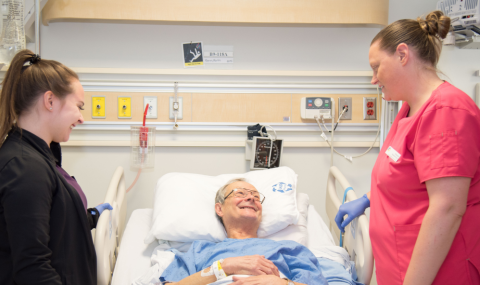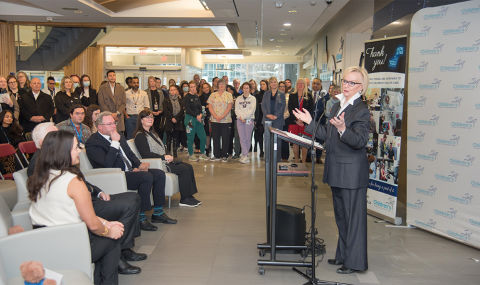MEDIA RELEASE
For Immediate Release:
February 3, 2012
Accreditation Canada recognizes five areas of innovation and creativity
(LONDON, Ontario) – Yesterday, London Health Sciences Centre was acknowledged by Accreditation Canada at their annual ‘Recognizing Excellence in Health Care Quality Conference’ for leading the way in five areas of patient care. The five areas were awarded leading practice designations, which is defined as “a noteworthy practice carried out by a health service organization which demonstrates innovation and creativity, and has a positive impact on services or outcomes for clients and families”.
Each of the leading practices will be highlighted on the Accreditation Canada website, and are often used by peer hospitals as development tools to assist in improving care in their own facilities.
“At London Health Sciences Centre we are committed to providing compassionate, high quality care to our patients and their families,” says Bonnie Adamson, President and CEO. “These exemplary practices demonstrate the exceptional leadership, innovation and dedication to quality service delivery that LHSC patients deserve”.
The five leading practices which received designation are:
• Family Feedback Program - Children’s Care Program
• Shower and No-Dressing Technique for Tunneled Central Venous Catheters (CVC’s) in Patients Receiving Hemodialysis - Renal Program
• Implementation of a Foot Assessment Program in a Regional Hemodialysis Setting - Renal Program
• Prevention of Nosocomial Infection in the Neonate; Targeting Central Venous Catheter Bloodstream Infection (CVC-BSI) in the Neonatal Intensive Care Unit - Children's Care Program
• Management of the Hemiplegic Arm: Implementing a Best Practice Protocol - Medicine Program
Further information on these practices can be found on the Accreditation Canada website and in the attached summary.
About London Health Sciences Centre
London Health Sciences Centre has been in the forefront of medicine in Canada for 137 years and offers the broadest range of specialized clinical services in Ontario. Building on the traditions of its founding hospitals to provide compassionate care in an academic teaching setting, London Health Sciences Centre is home to Children's Hospital, South Street Hospital, University Hospital, Victoria Hospital, two family medical centres, and two research institutes - Children's Health Research Institute and Lawson Health Research Institute, a joint research initiative with St. Joseph's Health Care, London. As a leader in medical discovery and health research, London Health Sciences Centre has a history of over 50 international and national firsts and attracts top clinicians and researchers from around the world. As a regional referral centre, London Health Sciences Centre cares for the most medically complex patients including critically injured adults and children in Southwestern Ontario and beyond. The hospital's nearly 15,000 staff, physicians, students and volunteers provide care for more than one million patient visits a year. For more information visit www.lhsc.on.ca.
- 30 -
For media inquiries contact:
Kathy Leblanc
Corporate Communications and Public Relations
London Health Sciences Centre
519-685-8500, ext. 74772
kathy.leblanc@lhsc.on.ca
After-hours assistance: Call LHSC Switchboard at 519-685-8500 and ask to page the communications consultant on-call.
Visit the LHSC Media web site at www.lhsc.on.ca/media
Backgrounder
Leading the way in patient care
A summary of LHSC’s 2012 leading practices
1. Family Feedback Program - Children’s Care
This Leading Practice is a system for collecting family feedback that ensures families have an accessible way to report about their care experiences. The practice includes the provision of cards containing short survey questions and open space for narrative comments to patients and families. Survey questions contained within the cards have been designed to elicit timely and unit-specific
feedback about the core concepts of family-centred care, such as information sharing, collaboration, communication, facilities, safety, respect and courtesy. The program allows leaders and committees working to enhance family-centred care to consider the family perspective through specific questions about family-centred care practice behaviours. Feedback received through the program provides information that allows a unit to focus initiatives in a manner that will lead to the achievement of the highest quality care possible.
2. Shower and No-Dressing Technique for Tunneled Central Venous Catheters (CVC’s) in Patients Receiving Hemodialysis - Renal Program
This Leading Practice is a first of its kind procedure which addresses safe showering practices and no-dressing application for the care of tunneled central venous hemodialysis catheters. Patients on conventional (thrice weekly) hemodialysis that meet inclusion/exclusion criteria are able to learn a safe new cleansing technique for tunneled CVCs that allow them to shower. This innovative technique not only improves quality of life and overall state of wellbeing for patients, it also allows patients to be more participatory as self-managers within their chronic illness.
What is hemodialysis?
Hemodialysis is a treatment for kidney failure which removes waste products from the blood.
What is a tunneled central venous catheter?
A tunneled central venous catheter (CVC) is a long-term intravenous device which provides vascular access through which blood is removed and returned to the body. Traditionally, tunneled CVCs are covered with sterile dressing which must be kept dry to prevent infection.
3. Implementation of a Foot Assessment Program in a Regional Hemodialysis Setting - Renal Program
This Leading Practice is a foot assessment program which reduces foot complications among patients on hemodialysis. Supporting a proactive approach
to managing foot problems in a high-risk population, the evidence-based program includes monthly foot assessments for patients deemed high-risk and annual foot assessments for those deemed low-risk, as well as education to patients and families on how to care for their feet and reduce risk for developing complications. This first of its kind program in Canada encourages self-management around the care of high-risk feet and promptly identifies problems providing a timelier referral to the appropriate services.
4. Prevention of Nosocomial Infection in the Neonate; Targeting Central Venous Catheter Bloodstream Infection (CVC-BSI) in the Neonatal Intensive Care Unit - Children's Care
This Leading Practice is a set of quality improvement activities which target both insertion and maintenance care of CVCs in neonatal patients – a population which is at risk for infection due to their immature immune systems, exposure to personnel and invasive procedures. The series of quality improvement activities are packaged into two “care bundles” – insertion and maintenance. Each bundle contains a number of components, such as standardization of catheter insertion technique, formation of a dedicated CVC insertion team, daily site monitoring, and monthly tracking of CVC-BSI rates, which when combined help to reduce or eliminate CVC-BSI rates.
Why do neonates require CVCs?
CVCs are essential for providing neonatal patients with medicine and nutritional support.
5. Management of the Hemiplegic Arm: Implementing a Best Practice Protocol - Medicine Program
This Leading Practice is a best practice toolkit that will better manage hemiplegic arms in stroke patients. The Hemiplegic package is a toolkit that includes instructions on how to implement the best practice guidelines, photos of proper positioning of the patient, audits and many other resources for application. It is used to first educate staff and then to involve patients and families in the care process through education and instruction on positioning. Implementation of this best practice improves knowledge for all staff, patient and family members on the proper handing of hemiplegic arms. It decreases risk of damage and assists in proper positioning in general for the patients.
What is hemiplegia?
Hemiplegia refers to paralysis on one side of the body. When hemiplegia is caused by a stroke, it often involves muscles in the face, arms and leg.


